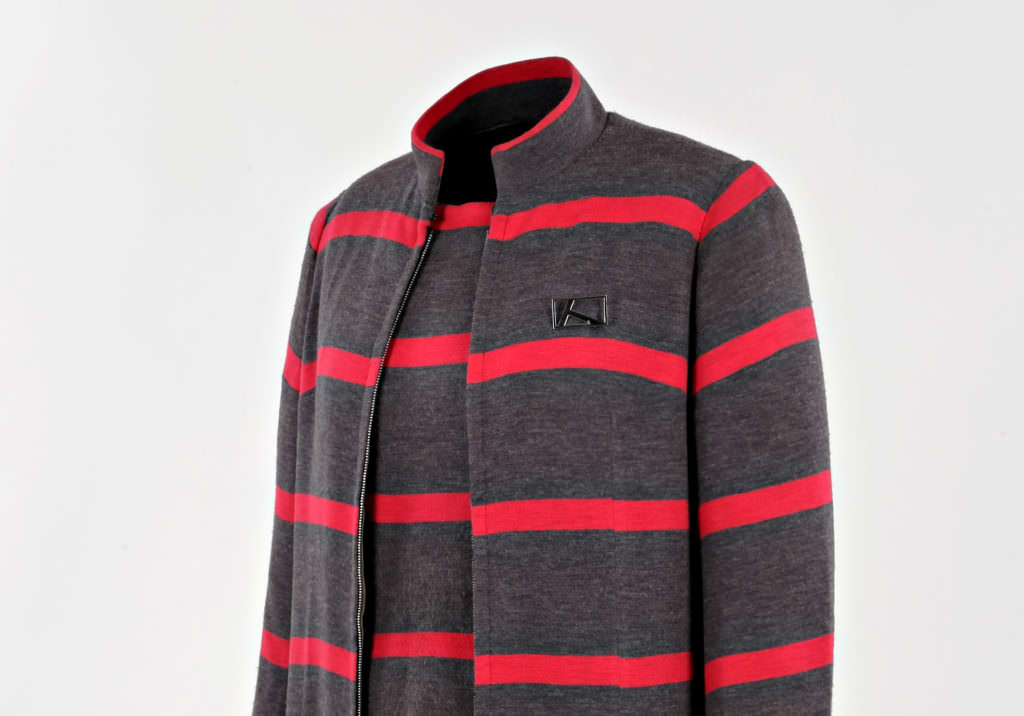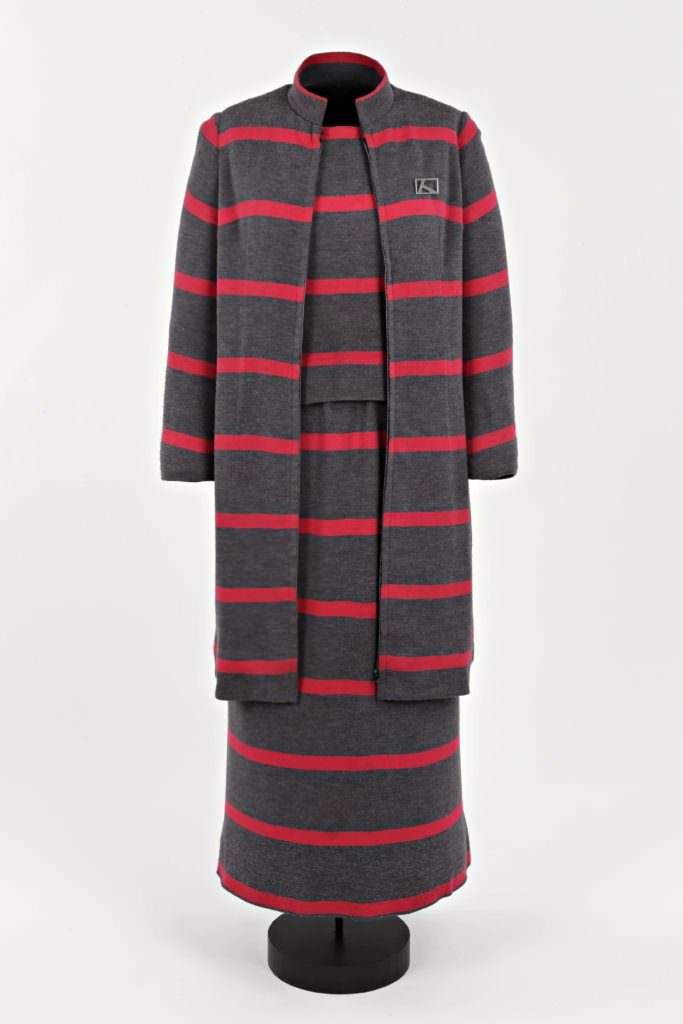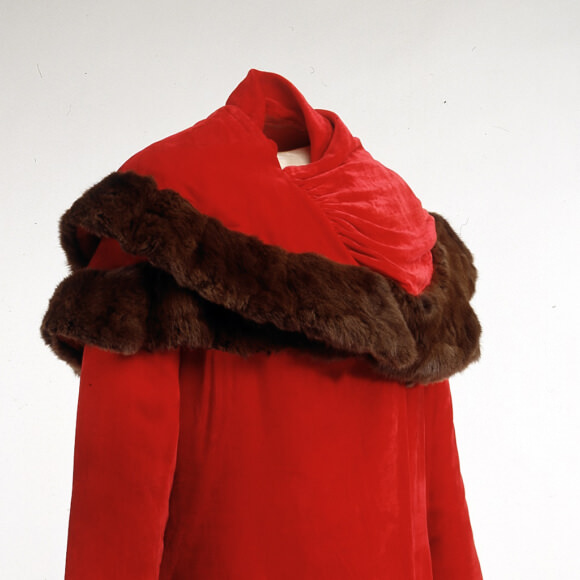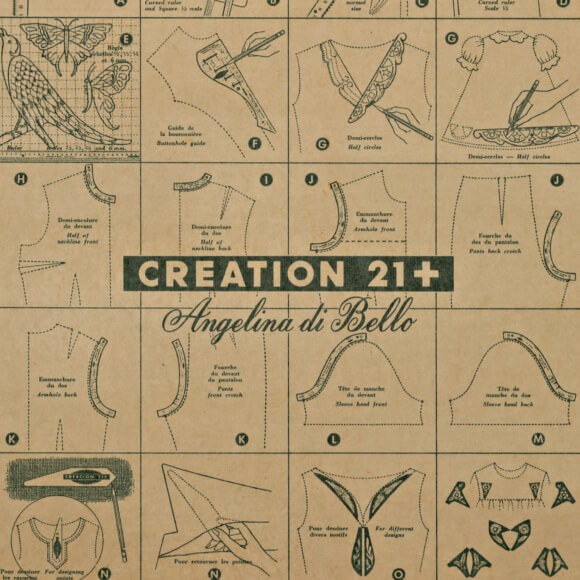
Christian Pavilion Hostess Uniform, Expo 67, France Davies, 1967. Gift of Dr. Esmerelda M.A. Thornhill, M2016.93.1.1-3 © McCord Museum
France Davies was born in 1927 to Canadian parents who were living in Paris. In 1941, the Davies returned to Canada because of the war, and their daughter became a Canadian citizen. In the spring of 1947 when she was 19 years old, France Davies won a scholarship to study couture in Paris. She learned cutting techniques at the École Guerre-Lavigne, and took drawing courses at the École Duperré, in Montmartre. After coming home to Montreal, she approached Raoul-Jean Fouré for a job in 1949 and was hired as a cutter. She perfected her skills working alongside the famous couturier, whom she later noted was not only refined and creative, but an excellent teacher. A year later, when Fouré had to reduce his staff, she decided to open her own studio.
In March 1950, at the age of 22, she began working from the building where she lived with her parents, at 1610 Sherbrooke Street West, with several friends as her first clients.
She soon attracted a loyal clientele, mostly Montreal women of means.
When a 1952 fire destroyed the building housing her workshop, she moved to a small apartment at 1575 Summerhill Avenue, which she shared with her mother. In 1957, she established a real dressmaking salon at 2150 St. Marc Street, where she received clients until the building was sold in 1964. She then returned to Sherbrooke Street West, number 1617, on the corner of Côte-des-Neiges, where she set up a two-storey salon over offices occupied by the Bank of Montreal. Finally, for the two last years of her career, 1966 to 1968, she came full circle and moved her salon back into 1610 Sherbrooke Street West, where she had lived with her parents upon their return to Canada until the 1952 fire. In 1968, France Davies Cawadias, who had been married for three years, decided to live full-time with her husband in Ottawa, thus ending her passionate relationship with couture.
Focussed more on quality than quantity, she never had more than two employees. Usually working with just one finisher, she would produce two or three garments a week.
France Davies’ technique was to propose a design to the client and create a drawing, on the spot, to illustrate her idea. She would try to understand the woman sitting across from her, try to discover the image in the client’s head, so she could create a garment that would bring her client close to this ideal, while still being comfortable. She believed that a fashion house must be capable of supplying a full range of wardrobe needs, so her repertoire included dresses, suits, coats and blouses. She liked working with wool for the way it holds it shape, and even used it in evening gowns, with much success.
She also enjoyed working with silk and silk chiffon, which she once noted were “hard to work with, but can float, flutter, and sing!”

Christian Pavilion Hostess Uniform, Expo 67, France Davies, 1967. Gift of Dr. Esmerelda M.A. Thornhill, M2016.93.1.1-3 © McCord Museum
She happily applied her talents to every kind of garment, whether it was a ball gown, a severe suit, or “a little embroidered organdy dress that radiates charm and freshness.” Although she claimed she was unable to make line-for-line copies, she was open to borrowing ideas. She believed in taking advantage of any opportunity to try something new.
She also maintained that, although many couturiers often worked with similar ideas, this was simply due to the normal circulation of trends.
Clients themselves sometimes provided sources of inspiration, bringing garments by major designers like Givenchy or Dior to their couturiers. France Davies also read L’Officiel de la couture et de la mode de Paris, a French journal that featured all the French collections. One of her first clients, Lady Davis, the wife of an Imperial Tobacco magnate, brought her some fabric and a dress by Lanvin one day, and asked her to copy it. She responded that she could not make the Lanvin piece using the fabric in question and instead suggested an original idea. To which Lady Davis exclaimed, “Do you think you can do better than French couture?” and stormed out the door. And yet, the next day, the client ordered the proposed model: young Davies had earned her admiration.
Throughout her career, she would sign her name, France Davies, by hand in ink on a piece of satin ribbon that she sewed into every piece. One day, Mr. Louis, a manager at the Montreal office of French silk manufacturer Bianchini-Férier, said to her, “You have the name of a couturier. Never change it!”
Although France Davies’ reputation grew without advertising, her achievements attracted media attention.
In 1951, the City of Longueuil commissioned her to create an article of clothing to be offered to Princess Elizabeth during her official visit.
Using a hand-woven tartan from Véronique Arsenault, she created a full pleated skirt with a wide shaped waistband. Soon after, Dupuis Frères licensed the design and began advertising copies of the princess’ plaid skirt in the pages of Montreal newspapers. Her creations were often seen in the fashion pages of Canadian newspapers: in October 1955, the women’s section of the Globe and Mail featured one of her dresses alongside those by Paris designers Givenchy, Balmain and Rouff. In 1967, she designed the hostess uniforms for the Christian Pavilion at Expo 67.
She dressed well-known performers and women working in media, including Maureen Forester, Lisette Bourassa, Odile Panet-Raymond, Lucette Robert (a journalist at Revue populaire), Michelle Tisseyre, singer Lise Roy, as well as figures from politics and finance, such as Marguerite Charland (the wife of Ambassador Claude Charland) and Mrs. C. D. Howe and one of her daughters. She also worked for the theatre, notably creating costumes for Menotti’s opera buffa The Telephone, presented in February and March 1952 at the Théâtre Gesù in Montreal.
In 1954, France Davies played an active role in founding the Association of Canadian Couturiers. As a member, she would present five or six original pieces in its two annual fashion shows. She also held the position of secretary for nearly the entire duration of the Association’s 14-year existence. Along with Raoul-Jean Fouré, she was one of the few to remain in the group until it disbanded in 1968. Her archives are now preserved in the McCord Museum.
Publication date
01/10/2004
Writing
Dicomode
Share
DownloadRecommended entries
© MCCORD STEWART MUSEUM 2025






